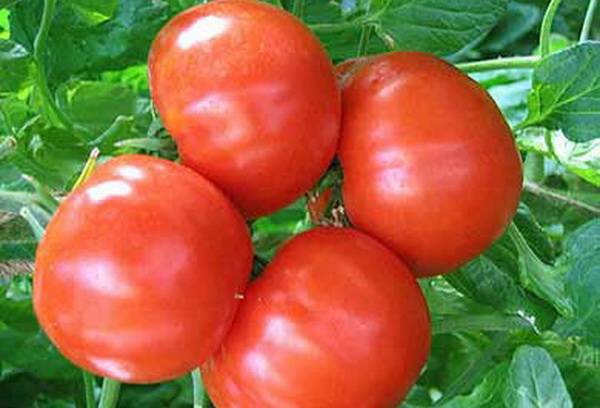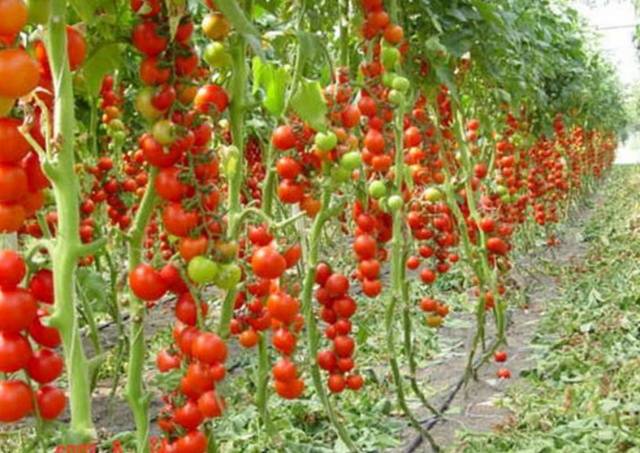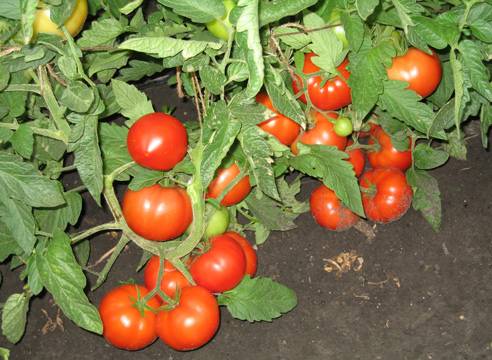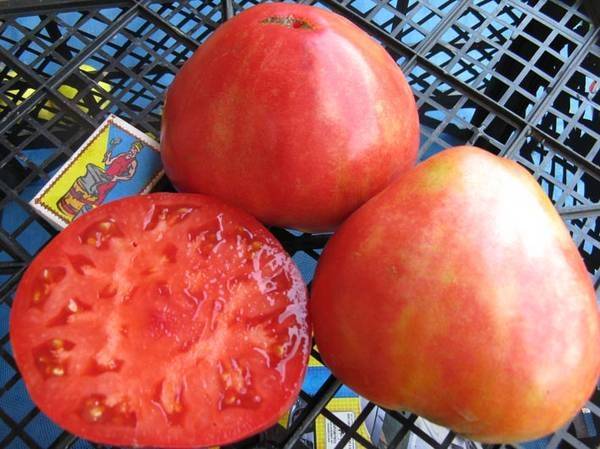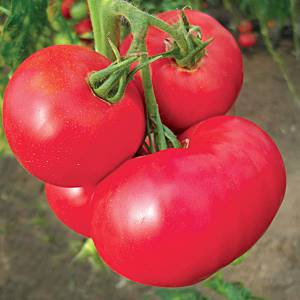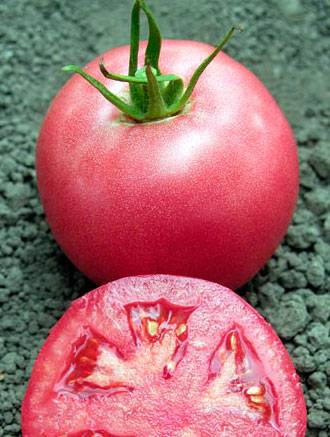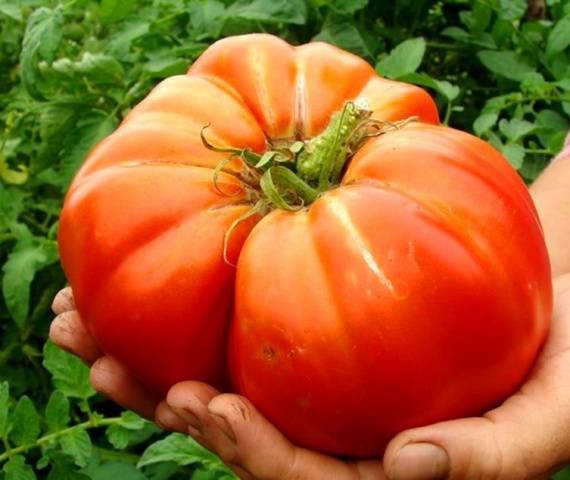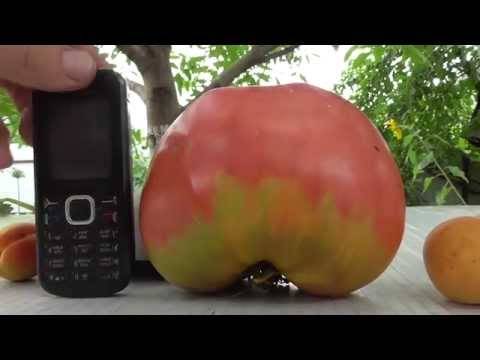Content
For optimal use of greenhouse areas when growing tomatoes, it is necessary to combine determinant and indeterminate varieties.
Determinant tomato varieties differ from indeterminate the fact that they have a stop in growth after reaching genetically programmed limits. While indeterminate ones can grow as long as weather conditions permit. In greenhouses, this means virtually uninterrupted growth.
Determinant tomato varieties usually not very productive in comparison with indeterminants and low, therefore they are planted either in low greenhouses, or along the perimeter of high greenhouses, where the roof drops.
In tall greenhouses, indeterminate varieties are planted closer to the center, allowing harvesting for several months.
Determinant varieties have an advantage over indeterminants in terms of ripening. They ripen earlier than the second. Their downside is that the fruiting period is limited.
They try to choose determinant varieties of tomatoes for greenhouses not only taking into account the yield and size of the fruits, but also according to their resistance to diseases, which is especially important when growing in greenhouses, where it is difficult to withstand the necessary modes of humidity and temperature. In greenhouses, there may be a lack of lighting or too low temperature, temperature changes can be much sharper than natural ones. High humidity often causes fungal diseases of plants. At the same time, tomato bushes should give a stable harvest.
Given these conditions, the requirements for determinant varieties grown in greenhouses are much stricter than for varieties for open ground. The undisputed leaders of determinant varieties tomatoes for greenhouses are f1 hybrids, bred taking into account all the necessary qualities.
Determinant hybrids for greenhouses
Bourgeois F1
The hybrid was bred in Odessa. Grows equally well in greenhouse conditions and in the open air in the south of Russia and in the middle lane. North of "Bourgeois" can only be grown indoors.
When selling this variety, different companies may designate it as early or mid-season, so you should focus on the growing season. At "Bourgeois" from the moment of planting seedlings to the opportunity to collect the first ripe fruits, it takes 105 days.
Determinant hybrid. Standard bushes, tall. Height 80-120 cm. In the south, they can grow up to 1.5 m. The size of tomatoes is average, weight up to 200 g. The very first ones can grow up to 400 g.
The variety is very suitable for canning. Thanks to the good ratio of acids and sugars in fruits, a tasty juice is obtained from "Bourgeois".
The disadvantages of this hybrid include fragile branches that require binding.
Productivity from 7 to 12 kg / m² (with good care). Planting density 3-4 bushes per meter. For cultivation on an industrial scale, the hybrid is not recommended due to the lack of a guarantee of a high yield. "Bourgeois" is intended for personal subsidiary plots.
Advantages of "Bourgeois"
The main advantages of "Bourgeois" are noted by both professionals and amateur gardeners:
- high keeping quality of fruits;
- resistance to temperature fluctuations;
- relative drought resistance;
- immunity to TMV, verticillosis, as well as to black leg and apical rot;
- versatility of the use of tomatoes.
When growing a variety, it must be fed with complex fertilizers and protected from pests, since, with all its resistance to fungi and viruses, the plant is not able to resist spider mites, Colorado beetles or slugs.
Openwork F1
The ripening time of the hybrid fruit is similar to that of "Bourgeois" and is 105 days. "Azhur" is a standard determinant plant up to 90 cm high. It is included in the State Register of the Russian Federation and is recommended for cultivation in greenhouse conditions and in open beds.
Fruits are medium, weighing up to 280 g. The very first tomatoes can grow almost twice as large.
The advantages of the variety include a consistently high yield, thanks to which it is recommended for industrial cultivation and is loved by summer residents. It was originally developed as a greenhouse crop for the northern regions of Russia. It can be grown outdoors in the southern regions, where it shows good yields. In the Trans-Ural regions, the hybrid is grown exclusively in greenhouses.
Resistant to the most common greenhouse diseases of tomatoes.
The hybrid forms ovaries in bundles of 5 fruits each. One branch can have up to 4 bunches. If you need to get large fruits, no more than 3 ovaries should be left in a bunch, and 2 bunches on a branch. For a season from 1 m², you can get up to 12 kg of tomatoes.
The variety is versatile: it can be processed into juice and tomato paste or consumed fresh.
Like any high-yielding plant, "Azhur" has an increased need for mineral and organic fertilizing.
Doll Masha F1
Hybrid for greenhouses. Determinate bush, up to 90 cm high, standard... Recommended for growing in all regions of Russia, as it grows in greenhouses. The yield of the hybrid is up to 8 kg / m². Needs additional feeding.
Fruits are pink, weighing up to 250 g. Ovaries are formed in bunches of 5 pieces each. Tomatoes have excellent keeping quality.
Also, the resistance to diseases of tomatoes can be attributed to the positive qualities of the variety.
Olya F1
The best variety for commercial cultivation. Recommended for greenhouses where it can grow all year round. Cold-hardy, early ripening, resistant to diseases of tomatoes in the greenhouse. Super determinant shrub, great for glass and polycarbonate greenhouses.
At each node, it forms three clusters of inflorescences, located every 1-2 leaves from each other. Ovaries in each hand up to 9. Ovaries can form at rather low temperatures (+ 7-13 ° C).
Sweet and sour fruits weigh 135 g. The variety differs from other tomatoes in the even size of the fruit: the diameter is about 65 mm. Preferable for fresh consumption, also suitable for processing.
Productivity up to 25 kg / m².
Fans of large-fruited determinant varieties of tomatoes for greenhouses can pay attention to the following varieties. The flesh of these varieties is most often fleshy, well suited for salads, but juice there is little in it.
Large-fruited varieties of tomatoes for greenhouses
Alsou
One of the best greenhouse tomatoes. A determinant variety of tomatoes developed in the current century, the height of the bush of which is 0.8 m. It is not a shtambov one, therefore, it requires the formation of a bush in two or three stems and pinching.
The variety is not hybrid, which means that it is possible to collect seeds for sowing next year. Early ripe. It only takes 90 days from sowing to harvesting the first fruits.
Recommended for indoor and outdoor cultivation in Western and Eastern Siberia, as well as in the Urals. In more northern regions, the variety is grown only in greenhouse conditions.
The fruit is red when ripe, but the color is not saturated. The weight of a tomato can reach 500 g, which is why the Alsou bushes require a garter. Otherwise, they may break under the weight of the tomatoes. The taste of the fruit is sweet, without sourness. You can collect up to 9 kg of fruits per sq. m.
"Alsou" forms single ovaries, unlike bundle varieties.In general, the variety is versatile, used fresh and suitable for conservation.
The disadvantages of the variety are:
- weakness of young seedlings and seedlings;
- unsuitability for canning whole fruits: does not fit into the standard neck of the jar.
Advantages of "Alsou":
- high resistance to the most common diseases;
- large fruits;
- great fruit taste;
- the possibility of long-term storage;
- good transportability.
F1 doll
A recently bred determinant hybrid that has already entered the top ten indoor cultivars. The bush is only 0.7 m high, but the fruits can weigh up to 400 g, and there is more than one tomato on the branch, so the bush needs to be tied up. The yield of the variety is up to 9 kg per square meter.
The seeds of second-generation hybrids are split into parental forms, and the heterosis effect that allows such luxurious fruits to be obtained disappears. In the case of hybrids, annual purchase of seeds from the grower is justified.
Fruits are pink in color with a classic round shape. A tomato contains an average of 5 chambers. The pulp is fleshy, sweet. The content of saccharides in the fruit of the hybrid is up to 7%.
The appointment is universal. "Failed" small fruits are well suited for conservation.
"Doll" has good keeping quality and transportability.
F1 North Spring
Determinant tomato variety intended for cultivation in unheated greenhouses in the zone of risky farming from the SeDeK company. Early ripe. Fruits up to 350 g, pink. The pulp is fleshy, juicy.
The bush is up to 0.6 m high. The yield of the variety is up to 8 kg per square meter. m. Resistant to verticillium.
Pride of Siberia
Siberians have one peculiarity: they suffer from gigantomania a little. And varieties tomatoes of Siberian selection this is confirmed.
The determinant bush of the Pride of Siberia variety reaches a height of one and a half meters. Fruits can weigh 950 g, usually do not exceed 850 g. Ripe red tomatoes.
The variety is early maturing. From planting seedlings to the first ripe fruits, it takes 95 days. Pride of Siberia can be grown outdoors, although it grows much better in greenhouses. Since the variety was originally intended for greenhouses, it is recommended for cultivation in all regions of Russia. In the south, it can be grown outdoors.
One bush can produce 5 kg of tomatoes. With a planting density of 4-5 bushes per meter, up to 25 kg of tomatoes can be removed from 1 m². In theory, the variety is versatile. It is good fresh, suitable for making juice or pasta. The idea of winter harvesting can meet only one obstacle: too large a fruit that cannot be preserved whole. But it will be good in a vegetable platter.
The advantages of the variety include disease resistance, selected fruits, excellent taste and high yield.
The disadvantages include weak branches of the bush that need props.
The peculiarities of cultivating the variety include the increased need for phosphorus and potassium during the growing season and the demand for watering. To increase yields, only two stems are left on the bush. The rest are removed.
Grandee
A mid-season variety bred by the Siberian Research Institute of Radiology. The growing season is 115 days.
One of the best varieties of the Trans-Ural selection. The variety is determinant, not standard. Requires the formation of a bush by pinching. The height of the bush is from 0.6 m. It can grow up to one and a half meters.
Fruits are pink, heart-shaped. If you let things take their course, the fruits will grow up to 250 g. To increase the size of the fruit, pinch the flowers, leaving no more than five ovaries on the branches. In this case, tomatoes grow up to 400 g. Occasionally up to a kilogram.
It is not recommended to plant more than 4 bushes of this variety per sq. m.Yields vary from region to region. The maximum was recorded in the Omsk region: up to 700 c / ha.
In the northern regions it is recommended for growing in a greenhouse, in the south it grows well in the open field.
The advantages of the "Grandee" are:
- unpretentiousness to weather conditions and frost resistance;
- high productivity;
- excellent taste of tomatoes. With proper care, the fruits are sugary;
- good keeping quality and transportability;
- disease resistance.
The variety is more suitable for salads and juicing. It is too large for preservation with whole fruits.
The disadvantages include mandatory feeding, pinching, regular abundant watering, regular loosening of the soil and the obligatory garter of the stems.
Tips from experienced gardeners
- To stimulate the fruiting of tomato bushes, you can put buckets of manure or fermenting grass in the greenhouse. Fermentation will increase the concentration of carbon dioxide in the air. With a high carbon dioxide content in the atmosphere, the fruits grow larger.
- To increase the size of fruits from determinate varieties of tomatoes, several ovaries must be cut from each cluster. The remaining tomatoes will grow more actively and will grow 2 times larger than usual. "Experienced" vegetable growers talk about tomatoes weighing 1 kg. But ... if there are "hunting" and "fishing" tales, then why not be a "gardener"? Of course, if we are not talking about large-fruited varieties.
- In a greenhouse, it is better to grow several varieties at the same time, including both determinant and indeterminate. In addition to variety, this technique guarantees a harvest.
- If the flowering of the bushes is not very active, it is necessary to remove the lower ovaries. The bush freed from excessive load later will tie twice as many fruits.
There are many varieties of tomatoes. Both determinant and indeterminate. You can experiment for years in search of the best variety, or, having planted several varieties at the same time, over time, stop at those that suit the most.
